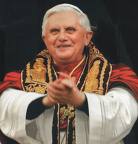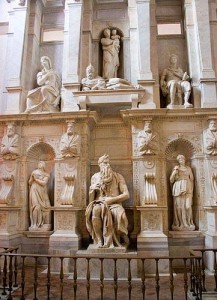Today, Pope Benedict XVI greeted pilgrims at the weekly audience. What a grand way to begin the Consistory pilgrimage! Read more about the audience. Following the audience, pilgrims left St. Peter’s to travel to the Church of St. Peter in Chains. Here we remember that Peter was imprisoned in Jerusalem and the chains at the base of the altar are said to be the chains that imprisoned him. While at the church, the pilgrims will also see Michelangelo’s famous statue of Moses with “horns.” These horns were popular among artists in Medieval time as a symbol of holiness because in Hebrew, the word for “beams of light” and “horns” is similar. The exterior horns are a sign of the interior radiance of the Lord.
Read: Luke 19:11-18
Reflect: Fr. Justin Huber was the celebrant of the Pilgrmage Mass and asked pilgrims to conside what our checkbooks and our calendars say about the outward expression of our interior lives.
“…the Lord uses this parable to speak to us about the perennial truths of the spiritual life. It is interesting to note that money is the tool that is able to store and transport material or worldly value. It acts as a neutral intermediary between good ands services, which can be converted into nearly anything. But, one could ask: could a carrier of material value be converted into something of spiritual value? Is there something that stands at this interface between the material and the spiritual?
It has been said that if you want to know what a person truly values in life, then look at their calendar and their checkbook. Time and money are the two resources that we use to acquire the things that we value. In our Gospel today, Christ is inviting each of us to invest what we value most. Beyond just time and money, he is asked each of us to offer over to him our entire life; this includes our gifts and our talents and all that we are. For, it is none other than Christ who stands at the interface between the material and the spiritual. Union with God is both the origin and the final goal of humanity and it is Christ who leads us back to the father. It is in Christ’s will, in the offering of our lives over to his will, that we find the opportunities that will lead to our own growth and that of the Kingdom of God. Anything less is not merely standing still, but it is moving backward.
On Wednesday, October 20th, shortly before announcing the Consistory, which will create 24 new cardinals, Pope Benedict XVI remembered the life of St. Elizabeth of Hungary. She offered over her life, the life of a noblewoman, to the service of the poor. As providence would have it, we celebrate her feast today, 779 years after this humble woman’s death.
Saint Peter also offered over his life. The humble fisherman, who became the Prince of the Apostles, placed his entire life, the good and the bad, in Christ’s hands and it was transformed. The chains beneath this altar, which are said to have bound him as he lie in prison in Jerusalem, were miraculously unfastened by an Angel, as accounted in the Acts of the Apostles. Today, we still venerate them as a sign of the transformative power of God. The place of his burial has now been transformed into the largest Basilica on Earth and has become a place of spiritual pilgrimage, a place were we will go to pray on Saturday morning as Cardinal-designate Wuerl will receive the red biretta and become Donald Cardinal Wuerl.
Indeed, even Rome stands as a visible witness to the transformative power of God. The art and architecture, which has transformed the city, dot the paths of the saints, who were transformed by God and who themselves transformed the Church. As we follow these paths on our pilgrim journey, we offer our lives anew to the Lord, who alone has the power to bring extraordinary growth from the ordinary offering of our daily lives.”
Respond
Take a look at your checkbook and calendar for the past month…what is it saying?
Follow our photo diary
The Pilgrimage Facebook page is also here:


